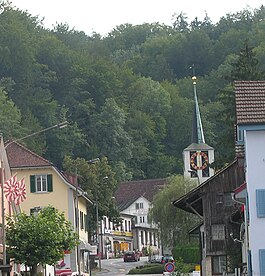Fällanden
| Fällanden | ||
|---|---|---|
 |
||
|
||
| Coordinates: 47°22′N 8°38′E / 47.367°N 8.633°ECoordinates: 47°22′N 8°38′E / 47.367°N 8.633°E | ||
| Country | Switzerland | |
| Canton | Zurich | |
| District | Uster | |
| Area | ||
| • Total | 6.38 km2 (2.46 sq mi) | |
| Elevation | 491 m (1,611 ft) | |
| Population (Dec 2015) | ||
| • Total | 8,340 | |
| • Density | 1,300/km2 (3,400/sq mi) | |
| Postal code | 8117 | |
| SFOS number | 0193 | |
| Localities | Fällanden, Benglen, Pfaffhausen | |
| Surrounded by | Dübendorf, Greifensee, Maur, Schwerzenbach, Zurich | |
| Website |
www SFSO statistics |
|
Fällanden is a municipality in the district of Uster in the canton of Zürich in Switzerland, and belongs to the Glatt Valley (German: Glattal).
Fällanden is first mentioned around 820 as Fenichlanda.
Fällanden has an area of 6.4 km2 (2.5 sq mi). Of this area, 40.8% is used for agricultural purposes, while 29.4% is forested. Of the rest of the land, 26.2% is settled (buildings or roads) and the remainder (3.6%) is non-productive (rivers, etc.). In 1996[update] housing and buildings made up 20% of the total area, while transportation infrastructure made up the rest (6.1%). Of the total unproductive area, water (streams and lakes) made up 1.2% of the area. As of 2007[update] 26.7% of the total municipal area was undergoing some type of construction.
The municipality is an agglomeration that grew up from the village of Fällanden and the settlements of Benglen, Pfaffhausen und Neuhausen. It is located on the north-east slope of the Pfannenstiel mountain chain, with Greifensee lake nearby.
Bus lines branch toward Schwerzenbach, Duebendorf, Maur and uphill directly to Zurich, giving good enough connection for the people to work in central areas of Zurich. Fällanden has special bus lanes, ensuring efficient operation also in high traffic hours.
Fällanden has a population (as of 31 December 2015) of 8,340. As of 2007[update], 18.2% of the population was made up of foreign nationals. As of 2008[update] the gender distribution of the population was 49.3% male and 50.7% female. Over the last 10 years the population has grown at a rate of 12.6%. Most of the population (as of 2000[update]) speaks German (86.8%), with French being second most common ( 1.9%) and English being third ( 1.8%).
...
Wikipedia



